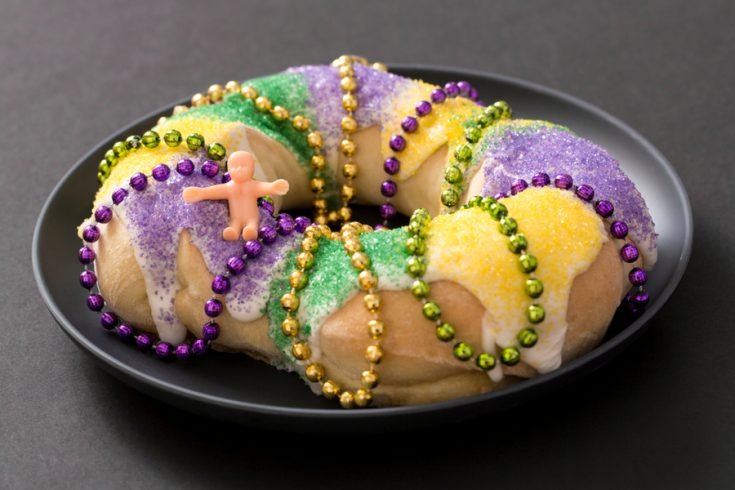Behold the traditional French Galette des Rois.
If you’ve spent any time in New Orleans or found yourself festooned with strings of colorful beads to celebrate the festival of Mardi Gras, you may be familiar with a Galette des Rois—known stateside as a King Cake or a Three Kings Cake.
Established in the Middle Ages as the official end to the Christian holiday season, Twelfth Night is the final night of the Twelve Days of Christmas—a partridge in a pear tree, anyone?—which is celebrated usually on January 6th* with this beautiful dessert made of flaky puff pastry and creamy frangipane filling.
In the United States, a variation on the galette takes on a ring shape, and is rather easy to identify (see below) due to its tri-colored appearance—gold to symbolize wealth and prosperity, green for growth, and purple for justice—but are you familiar with the origins of this annual tradition involving paper crowns and a plastic baby?
According to biblical reference (and many a Christmas carol) Twelfth Night commemorates the tale of the Three Wise Men (Three Kings, or Trois Rois) visiting the newborn Jesus Christ, and offering the child gifts of gold, frankincense and myrrh.
Nowadays, this celebration is commemorated in many Francophone households with a feast among family and friends—and a Galette des Rois as the pièce de resistance of the dinner table.
The most fun part of this tradition is searching for the tiny fêve (figurine) that’s hidden inside the galette, symbolizing the Baby Jesus. In medieval times, a pea or a bean was used, and today any small token will do. If you’re the lucky person who receives the slice containing the fêve—just be careful not to swallow it!—you will be coronated as the official King or Queen for the night—complete with a paper crown to seal the deal.
Even though the origins of this little game are steeped in religion, it's become a secular tradition for everyone of all backgrounds to enjoy—including 85% of French citizens, according to a 2014 poll.
Ingredients and aesthetics of a Kings Cake can vary according to the traditions of different geographic regions—ranging around the world, from Northern France and Belgium to Quebec and the Creole community of New Orleans. Other cultures also have their own versions of this holiday, like Mexico’s El Día de los Reyes Magos. Mardi Gras revelers generally enjoy colorful slices of a denser cake drizzled with glaze, while European households tend to opt for the traditional round shape, with a simple but elegant design carved into the flaky pastry.
No matter how you choose to celebrate the holidays, if you find yourself suffering from a mid-winter depression once the ball has dropped and the decorations come down, why not add this fun New Year tradition to your January calendar?
Want to try your hand at making a traditional French Galette des Rois? Here’s a great recipe to get you started!
The alternative, colorful version of a King Cake, celebrated in New Orleans and around the United States along with Mardi Gras festivities.
*Some recognize this day on the 5th, depending on varying interpretations and the calendars of different religious denominations.

